Syracuse Orange
| Syracuse Orange | |
|---|---|
 | |
| University | Syracuse University |
| Conference | ACC, CHA, EARC |
| NCAA | Division I |
| Athletic director |
Daniel French (interim) John Wildhack (incoming) |
| Location | Syracuse, New York |
| Varsity teams | 20 |
| Football stadium | Carrier Dome |
| Basketball arena | Carrier Dome |
| Other arenas | Manley Field House |
| Mascot | Otto the Orange |
| Nickname | Orange |
| Fight song | Down the Field |
| Colors |
Orange[1] |
| Website |
www |
The Syracuse Orange is the nickname used by the athletic teams of Syracuse University. The school is a member of NCAA Division I and the Atlantic Coast Conference. Until 2013, Syracuse was a member of the Big East Conference. The school's mascot is Otto the Orange. Teams were previously known (until 2004) as the Orangemen and Orangewomen. The men's basketball, football, wrestling, men's lacrosse, and women's basketball teams play in the Carrier Dome. Other sports facilities include the nearby Manley Field House complex, the Tennity Ice Skating Pavilion, and Drumlins Country Club.
Important firsts
.jpg)
- Baseball team established: 1870
- Rowing team founded: 1874
- First recorded football game: 1884 vs. Medical College of Syracuse
- First intercollegiate football game: 1889 vs. University of Rochester
- First recorded basketball game: 1899 vs. Christian Association of Hamilton (Ontario)
- Lacrosse team founded: 1916
- First United States Intercollegiate Lacrosse Association championship: 1920
- First ACC Championship: Men's Cross Country, 2013
- First Women's National Championship: Field Hockey, 2015
Cross country
The cross country running teams at Syracuse University are currently coached by Head Coach Chris Fox, Associate Head Coach Coach Brien Bell, Assistant Coach Adam Smith and Assistant Coach Raynee DeGrio. Syracuse Cross Country competes within the Atlantic Coast Conference.
The Syracuse Orange Men's Cross Country Team has a well rooted history, with an NCAA Championship victory dating back to 1951. The Orange recently won their first Big East Conference title in 2009 and then defended the title in 2010, in which they hosted the meet at Jamesville Beach County Park located in Jamesville, New York. The team also won the NCAA Northeast Regional Championships in 2009 and 2010. At NCAAs, the team finished 14th place in both 2009 and 2010 with Tito Medrano earning All American Status in 2009 and Pat Dupont earning All American Status in 2010. In 2011, the Orange won the Northeast Regional Meet for a third consecutive time and placed 15th at the NCAA Championships held in Terre Haute, Indiana.
In their first year in the Atlantic Coast Conference, the men's cross country team took home the school's first ACC Championship title. The 2013 squad took 10th place at the NCAA Championships in Terre Haute, Indiana, their best performance since the 1950s. The Orange also won the 2103 NCAA Northeast Regional Title, taking the title 4 of the last 5 years.
The women's team has had great success in recent years as well. In 2008, the women's team made NCAA Nationals for the first time ever, and have made it every year since then. In 2010, the team finished an all-time best of 10th place. They have been a consistent top 3 team in the Big East over the recent years as well. In 2009, Katie Hursey won the NCAA Northeast Regional Championships individually, the first Orange in school history to do so.
Football
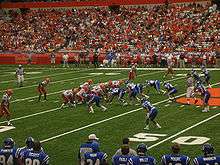
The Syracuse Orange football program is a college football team that currently represents Syracuse University as a member of the Atlantic Coast Conference.
The Syracuse University football program is also renowned for producing many All-Americans and College as well as Pro Football Hall of Famers. Among them are Ernie Davis, Jim Brown, Larry Csonka, Joe Morris, Art Monk, Jim Ringo, John Mackey, and Floyd Little. Among the current NFL Players are stars such as Ryan Nassib, Chandler Jones, All-Pro Defensive End Dwight Freeney, Shamarko Thomas, wide receiver Mike Williams and cornerback Will Allen.
Men's basketball
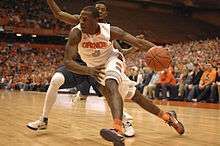
The Syracuse Orange men's basketball program is the intercollegiate men's basketball program of Syracuse University. The program is classified in the NCAA's Division I, and the team competes in the Atlantic Coast Conference. The Orange won the National Championship in the 2003 NCAA Men's Division I Basketball tournament. During the 2008–09, they played in, and won, a six-overtime thriller against a rival UConn team. The game was during the Big East Championship Tournament, and is the second longest NCAA Division I basketball game of all-time. Their recent success has included a trip to the 2013 Final Four. In the 2013–14 season they broke a record set two years prior by starting the season 25–0. The previous record was 20–0 set during the 2011–12 season. The 1917–18 and 1925–26 Syracuse teams were retroactively named the national champion by the Helms Athletic Foundation and the Premo-Porretta Power Poll.[2][3]
Women's basketball
The Syracuse Orange women's basketball program is the intercollegiate women's basketball of Syracuse University. The program is classified in the NCAA's Division I, and the team competes in the Atlantic Coast Conference. The head coach of the team is Quentin Hillsman.
Women's ice hockey
In 2008, Syracuse University announced that it would sanction a women's ice hockey team and become a member of College Hockey America. The team started playing in 2008.
Men's lacrosse
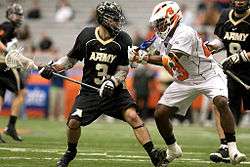
Syracuse fields a Division I NCAA college lacrosse team. Syracuse played its first intercollegiate lacrosse game in 1916, and captured its first USILL division championship in 1920. It would go on to win USILL championships in 1922, 1924, and 1925 and the USILA Division II co-national championship (Laurie Cox Trophy) in 1954. In the modern NCAA era, Syracuse has won ten national championships, with one additional championship (1990) vacated due to rules infractions. The Orange's ten national championship titles are the most of any team in NCAA Division I history. Most recently, Syracuse won the 2009 National Championship in a come-from-behind 10-9 overtime victory against Cornell University. Prior to that year, they won in 2008.
Men's soccer
Syracuse Orange is the NCAA college soccer team for Syracuse University in Syracuse, New York. They are a Division I team in the Atlantic Coast Conference and play their games at the Syracuse Soccer Stadium.
Notable non-varsity sports
Wrestling
Wrestling became a varsity level sport almost immediately after being introduced. The team was successful and, led by Gene Mills, had two undefeated seasons in 1979 and 1981, two NCAA championships, and went on to the Olympics and Wrestling Hall of Fame. The team was disbanded in 2001. In 2004 it was reformed with help from state funding as a club sport. It has received large mainstream success from 2008 to present. Led by Mills at the coaching helm, The Orange won a combination of 17 individual titles (Dake, Campbell, Herbst, Ness, Visconti, Langston, Young, Hudson, Pasquale, Ryder)
Baseball
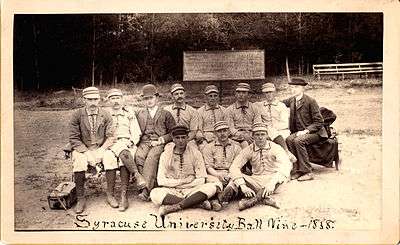
Syracuse's club baseball team was established in 1979 and has been successful in tournaments. The sport is currently played at the club level and the team is part of the National Club Baseball Association (NCBA).
Many students, alumni, citizens and other baseball enthusiasts in the area are in favor of an NCAA varsity team being formed on campus, but the athletic budget is a difficult barrier. In a September 12, 2006, story in The Daily Orange, Michael Wasylenko, chairman of the Athletic Policy Board, said Title IX and Syracuse's athletic budget is still a major crutch. "If we added a men's sport, we'd have to get rid of a men's sport . . . And that's probably not a good idea."
Men's ice hockey
Men's hockey competes at the ACHA Division I level in the Northeast Collegiate Hockey League. The school expressed interest in having a men's ice hockey team in the future, but these plans are on hold, in part because of Title IX.[4]
Rugby
Founded in 1969, Syracuse University Rugby Football Club plays in Division 1 in the Empire Conference. Syracuse has enjoyed success, including a trip to the Division 1 sweet 16 national playoffs in 2010.[5] Syracuse has participated in international tours to Europe, Argentina and Australia.[6] Syracuse are led by head coach Bob Wilson.[7]
Cycling
Syracuse University cyclists compete yearly in the Eastern Collegiate Cycling Conference starting in March.
Notable coaches, past and present
- Lew Andreas – Men's Basketball (1924–1950), Football (1922–1929)
- Jim Boeheim – Men's Basketball (1976–present) Basketball Hall of Fame
- Lew Carr – Baseball (1910–1942) Helms Foundation College Baseball Hall of Fame[8]
- Laurie D. Cox – Men's Lacrosse (1916–1930) National Lacrosse Hall of Fame
- Roy Danforth – Men's Basketball (1968–1976)
- John Desko – Men's Lacrosse (1999–present)
- Thomas Keane – Track and Field (1906–1945)
- Ted Kleinhans – Baseball (1947–1966)[9]
- Dick MacPherson – Football (1981–1991)
- Doug Marrone – Football (2009–2012)
- Frank "Buck" O'Neill – Football (1906–07, 1913–15, and 1917–19) College Football Hall of Fame
- Paul Pasqualoni – Football (1991–2004)
- Ben Schwartzwalder – Football (1949–1973) College Football Hall of Fame
- Scott Shafer – Football (2013–present)
- Roy Simmons, Sr. – Men's Lacrosse (1931–1969) National Lacrosse Hall of Fame
- Roy Simmons, Jr. – Men's Lacrosse (1970–1998) National Lacrosse Hall of Fame
- James A. Ten Eyck – Rowing (1903–1938)
Facilities
Carrier Dome

Built in 1980, the Carrier Dome is a 49,250-seat domed sports stadium located on the campus of Syracuse University. It is both the largest domed stadium on a college campus and the largest domed stadium in the Northeast. It is home to the Syracuse Orange football, basketball, and lacrosse teams. With regard to basketball, it holds another title, being the largest on-campus basketball arena, with a listed capacity of 33,000. This limit has been exceeded several times. The Dome sold an on-campus NCAA record of 35,446 tickets for a game against the Duke Blue Devils on February 1, 2014. The previous record was set on February 23, 2013 against the Georgetown Hoyas, with 35,012 in the stands.
Manley Field House
Built in 1962, this complex houses many of the offices of SU Athletics including the Equipment Room. It also contains academic rooms and two weight rooms strictly for Syracuse athletes only. Adjacent to the complex there are a variety of fields used for softball, soccer, field hockey, as well as a track for the track and field team. Manley was initially used as an indoor training facility for the football team, as well as a home court for men's basketball. Its seating capacity, 9,500, for basketball, at the time among the largest campus facilities in the Northeast, supported the rise to national prominence of the men's basketball program. The team shifted to the Carrier Dome after the 1980 season. In the final men's basketball game played at Manley, Georgetown snapped the Orangemen's 57 game home winning streak.
Carmelo Anthony Basketball Center
The name comes from current New York Knicks forward, Carmelo Anthony, who donated $3 million to the project. Anthony played one year with the Orange, the 2002-2003 season, in which he helped the program win its only NCAA Championship. It's a college basketball practice facility located in Syracuse, New York. The facility opened September 24, 2009. Both the men's and women's basketball teams for Syracuse University use the center. The facility houses two practice courts, locker rooms and office facilities for the men's and women's basketball programs at Syracuse. It is located on the north side of Manley Field House, in between the Roy Simmons Sr. Coaches Wing and the Comstock Art Facility.[10]
Tennity Ice Skating Pavilion
Home of the NCAA Division I Syracuse University women's ice hockey program playing in the College Hockey America conference. Named for donors Marilyn and Bill Tennity, the Pavilion opened in October 2000.
Drumlins Country Club
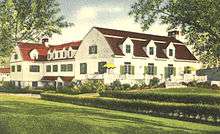
Owned by Syracuse University, the Drumlins Country Club, 800 Nottingham Road, DeWitt, New York, operates a private, 18-hole golf course; a public, 18-hole golf course; indoor tennis courts; and other facilities. The tennis courts are home of the Syracuse University's women's tennis team.[11][12]
Historic
Archbold Stadium
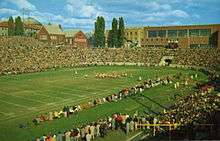
Thanks to a $600,000 gift by Syracuse University trustee and Standard Oil President, John D. Archbold, what was publicized as the "Greatest Athletic Arena in America" opened in 1907. Designed to resemble the Roman Colosseum and to never become outdated, Archbold Stadium became a trademark of Syracuse football. The stadium formed a massive concrete oval, 670 feet (204 m) long and 475 feet (145 m) wide. It was 100 feet (30 m) longer and only 22 feet (7 m) thinner than the Carrier Dome, and more than 6 million Orangemen football fans passed through its gates.
From 1907 until 1978, Archbold Stadium was the home of SU football. Archbold opened up with a bang when the Orange defeated Hobart 28–0. It went out in style 71 years later, with an improbable victory over second-ranked Navy 20–17. Syracuse posted a record of 265–112–50 at Archbold, and it housed many great teams. It was home of the 1915 squad, which was invited to play in the prestigious Rose Bowl and outscored its opponents 331 to 16. The 1959 team also called Archbold home en route to SU's only National Championship.
In 1978, SU fans said good-bye forever to the historic stadium. Archbold was demolished to make way for the new on-campus facility, the Carrier Dome, which opened in 1980.[10]
Championships
NCAA team championships
Syracuse University has won 15 NCAA team national championships.[13]
- Men's (14)
- Basketball (1): 2003
- Boxing (1): 1936
- Cross Country (2): 1951, 2015[14]
- Lacrosse* (10): 1983, 1988, 1989, 1993, 1995, 2000, 2002, 2004, 2008, 2009
- Women's (1)
- Field Hockey (1): 2015[15]
- see also:
Other national team championships
Below are 17 national team titles that were not bestowed by the NCAA:
- Men's
- Basketball∆ (2): 1918, 1926
- Cross-country (4): 1919, 1922, 1923, 1925
- Football (1): 1959
- Lacrosse (4): 1920#, 1922, 1924, 1925[16]
- Rowing (6): 1904, 1908, 1913, 1916, 1920, 1978
* After the 1990 championship, the NCAA Committee on Infractions determined that Paul Gait had played in the 1990 championship while ineligible. Under NCAA rules, Syracuse and Paul Gait's records for that championship were vacated. The NCAA does not recognize Syracuse and Coach Roy Simmons Jr.'s 3–0 record, and Paul Gait's 7 goals, 7 assists and his participation in that championship.[17]
∆ No title games or contemporary selections made. Retroactive selections by Helms and Premo-Porretta.
# Syracuse and Lehigh claim 1920 title based on winning their USILL divisions. No title game played. Syracuse-Lehigh game won by Lehigh.
Notable athletes
- Doc Alexander (1916–1920) – College Football Hall of Fame
- Gary Anderson (1978–1981) – All American kicker, Second all time in NFL scoring
- Carmelo Anthony (2002–2003) – NCAA Basketball Tournament Most Outstanding Player, Olympic Gold Medalist, Most points scored in Olympic play
- Dave Bing (1963–1966) – Basketball Hall of Fame, Mayor of Detroit
- Jim Brown (1954–1957) – College Football Hall of Fame, National Lacrosse Hall of Fame, Pro Football Hall of Fame
- Keith Bulluck (1996–1999) – All Pro linebacker
- Robin Butler Bright (1976–1980) – Three time All American in Swimming
- Matt Cappelli (2002–2006) – Rowing (sport). Holds record for shortest Division-1 athlete.[18]
- Michael Carter-Williams (2011–2013) – NBA Rookie of the Year
- Derrick Coleman (1986–1990) – Silver Anniversary Big East Basketball Team, All time Big East rebounding leader, NBA Rookie of the Year
- Tom Coughlin (1964–1967) – Head Coach, New York Giants
- Larry Csonka (1965–1967) – College Football Hall of Fame, Pro Football Hall of Fame
- Ernie Davis (1959–1961) – Heisman Trophy winner, College Football Hall of Fame
- Sherman Douglas (1986–1989) – Two time basketball All American, All time Big East assists leader, NBA Star
- Dennis DuVal (1970–1974) – Former NBA player and All-American basketball player
- Jonny Flynn (2007–2009) – Minnesota Timberwolves 2009 First Round selection, 2009 Big East Tournament MVP
- Dwight Freeney (1998–2001) – 6 time NFL Pro Bowl selection, 3 time NFL All-Pro selection, Super Bowl Champion, Indianapolis Colts all-time sacks leader
- Gary Gait (1986–1989) – 2 time National Player of the Year, 2 time McLaughlin Award (Midfielder of the Year) winner, National Lacrosse Hall of Fame, National Lacrosse League Hall of Fame
- Paul Gait (1986–1989) – National Lacrosse Hall of Fame, National Lacrosse League Hall of Fame
- Michael Gennaro (2007–2011) – Alternate for the 2012 London Olympics for Men's Rowing
- Dave Giusti (1959–1961) – Major League Baseball All Star, Sporting News Reliever of the Year
- Marty Glickman (1936–1939) – Football All American, Olympic sprinter
- Marvin Graves (1990–1993) – All time school passing yards leader
- Donté Greene (2007–2008) – Brooklyn Nets, player
- Tim Green (1982–1985) – College Football Hall of Fame
- Vic Hanson (1924–1927) – Basketball Hall of Fame, College Football Hall of Fame
- Marvin Harrison (1992–1995) – All American, Six time All Pro wide receiver
- Jason Hart (1997–2000) – All Big East First Team
- Wesley Johnson (2008–2010) – First Team All American, Big East All American, Naismith Award Finalist, Los Angeles Lakers, player
- Daryl Johnston (1985–1988) – Two time All Pro fullback
- Mark Kerr – 1992 All-American and NCAA Division I 190 lbs champion wrestler, two-time UFC tournament champion
- Jim Konstanty (1937–1939) – 1950 National League MVP, Saves leader
- Brad Kotz (1982–1985) – National Lacrosse Hall of Fame
- Felisha Legette (1984–1989) – Big East Women's Silver Anniversary Basketball Team
- Floyd Little (1964–1966) – College Football Hall of Fame, Pro Football Hall of Fame
- Ron Luciano (1957–1960) – Outstanding lineman, played professionally for the Detroit Lions, and Major League Baseball umpire
- John Mackey (1960–1962) – Pro Football Hall of Fame
- Julie McBride (2000–2004) – All time Syracuse women's basketball scoring and assist leader
- Donovan McNabb (1995–1998) – Big East Offensive Player of the Decade (football)
- Gerry McNamara (2002–2006) – Two time All Big East Basketball Team and NCAA National Champion
- Don McPherson (1985–1988) – Heisman Trophy runner-up, Maxwell Award winner (College Football Player of the Year), College Football Hall of Fame
- Dave Meggyesy (1959–1963) – NFL linebacker for seven seasons; author of Out of Their League in 1970; retired NFLPA Western Regional Director
- Herbert L. Mendelson (1948–1951) – Goalie – MVP 1951 Orangemen Lacrosse Team, All American Soccer Goalie
- Gene Mills (1977–1981) – National Wrestling Hall of Fame, 2 time NCAA Champion, 3 time World Cup Champion
- Martha Mogish (1978–1982) – Women's basketball star[19]
- Art Monk (1976–1979) – All American wide receiver, 3 time All Pro, Pro Football Hall of Fame
- Joe Morris (1978–1981) – All time Syracuse rushing leader, 2 time Pro Bowl selection
- Lawrence Moten (1991–1995) – 3 times All Big East Basketball Team, All time Big East scoring leader
- Jim Nance 1962–1965 All America wrestling, AFL All star
- Demetris Nichols (2003–2007) – Unanimous selection to All Big East Basketball Team
- Billy Owens (1988–1991) – Big East Men's Basketball Player of the Year, All American, NBA star
- Casey Powell (1995–1998) – 4 time All American, 2 time National Player of the Year (1997, 1998), Jack Turnbull Award (Attackmen of the Year) winner (1998), McLaughlin Award (Midfielder of the Year) winner (1996)
- Mikey Powell (2001–2004) – 4 time All American, 2 time Tewaaraton Trophy winner (2002, 2004), National Player of the Year (2004), 4 time Jack Turnbull Award (Attackmen of the Year) winner
- Ryan Powell (1997–2000) – 4 time All American, National Player of the Year (2000), Jack Turnbull Award (Attackmen of the Year) winner (2000)
- Leo Rautins (1980–1983)
- Andy Rautins (2005–2010) – Big East Second Team All American, Honorable All American Mention, Team Canada Basketball Player, 2nd All-Time in 3-point Field Goals Made in SU Basketball History, New York Knicks, player
- Jim Ringo (1950–1952) – Pro Football Hall of Fame
- Danny Schayes (1978–1981) – Academic All American, NBA star
- Rony Seikaly (1984–1988) – All American, Gold Medalist 1986 Basketball World Championships, NBA star, First ever draft pick of the Miami Heat
- Wilmeth Sidat-Singh (1935–1939) – Football and Basketball star, Pioneer of civil rights in college athletics
- Preston Shumpert (1998–2002) – Two-time All-Big East First Team selection
- Etan Thomas (1997–2000) – Twice Big East Defensive Player of the Year, Washington Wizards player
- David Tyree (1998–2002) – NFL Pro Bowl selection, Super Bowl Champion
- Hakim Warrick (2001–2005) – Big East Men's Basketball Player of the Year, Phoenix Suns player
- Dwayne "Pearl" Washington (1983–1986) – Silver Anniversary Big East Basketball Team
Nicknames, mascots and colors
Orange is the official school color, adopted as such in 1890. Prior to that time, the school's colors were rose pink and pea green. Orange, blue, and white are traditionally used for athletic uniforms.[20]
The athletic nickname derives from the official color. Prior to 2004, the official nicknames of the athletic teams were the "Orangemen" and "Orangewomen." These former nicknames are still affectionately used by some fans. However, beginning with the 2004–2005 school year, the official nickname was changed to the "Orange." This revision is gender-neutral, concise, and reflects the basis of the nickname as being the school color, as opposed to being derived from the Irish and Scottish Protestant fraternal organization.[21] Other nicknames over the years have included the "Hilltoppers," for the school's location on a hill, and the "Saltine Warriors," for a former mascot.
Mascot
In 1931, a Native American warrior known as Nathan March aka: "Saltine Warrior" became the athletic mascot. The name derived from an article describing an archaeological dig on campus allegedly uncovering the artifacts of a Native American warrior.[22] The warrior was called the "Saltine Warrior" because of the abundant salt deposits in the Syracuse, New York area. The article was later revealed to be a hoax, but the mascot remained for next four decades.
In the mid-1950s, the father of a Lambda Chi Alpha fraternity brother owned a cheerleading camp. He made a Saltine Warrior costume for his son to wear at Syracuse football games.[23] Thus began a nearly forty-year tradition of Lambda Chi brothers serving as the university's mascot.
In 1978, the Saltine Warrior was banned by the university as part of the national movement to eliminate Native American motifs, becoming one of the first colleges to do so. The mascot briefly morphed into a Roman warrior, but was eventually replaced unofficially in 1982 by a giant, cartoon-style Orange.[23]
Otto the Orange

The cheerleaders and mascots were at a UCA Cheerleading Camp in Tennessee that summer, and narrowed the field down to two potential names—"Opie" and "Otto." Figuring the name "Opie" would lead to the inevitable rhyme with "dopey," they settled on "Otto." Later that fall, word got out that the cheerleaders were calling the latest mascot costume Otto, and the name stuck.[24][25]
Otto the Orange was adopted by the university in 1995 as the university's official mascot, selected over a wolf and a lion also under consideration.[23]
References
- ↑ "Athletics Branding" (PDF). Syracuse University Brand Guidelines. Syracuse University. 2015-09-14. Retrieved 2016-03-23.
- ↑ "NCAA Division I Men's Basketball – NCAA Division I Champions". Rauzulu's Street. 2004. Retrieved May 14, 2014.
- ↑ ESPN, ed. (2009). ESPN College Basketball Encyclopedia: The Complete History of the Men's Game. New York, NY: ESPN Books. pp. 534–38. ISBN 978-0-345-51392-2.
- ↑ Wodon, Adam (2008-03-06). "Syracuse Women Joining CHA; No Men's Hockey Soon". Retrieved 2010-01-28.
- ↑ Rugby Mag, Empire Conference Play Starts, Sep. 9, 2011, http://www.rugbymag.com/men's-di-college/1893-empire-conference-play-starts-saturday.html
- ↑ Syracuse University RFC, About, http://www.cuserugby.com/about
- ↑ Syracuse University RFC, Team, http://www.cuserugby.com/team
- ↑ Kirst, Sean. (2013, July 18). "Amid renewed dreams of Syracuse University baseball, a drive to honor an Orange coaching legend," The Post-Standard. Accessed: June 4, 2014.
- ↑ Green, John F. (n.d.). "Ted Kleinhans," Society for American Baseball Research. Accessed: June 14, 2014.
- 1 2 (Source: SU Athletics)
- ↑ "Syracuse University Tennis: Quick Facts," SUAthletics.com. Accessed: December 24, 2013.
- ↑ "Drumlins: 'A Syracuse tradition since 1926,'" Drumlins.com. Accessed: December 24, 2013.
- ↑ http://fs.ncaa.org/Docs/stats/champs_records_book/Overall.pdf
- ↑ "Syracuse wins first Cross Country title in 64 years". National Collegiate Athletic Association. Retrieved 2015-11-22.
- ↑ "Syracuse tops UNC, claims national title". National Collegiate Athletic Association. Retrieved 2015-11-22.
- ↑ 2014 Syracuse Orange Lacrosse Media Guide. Syracuse University. 2014. pp. 110–111. Retrieved 2014-10-20.
- ↑ "NCAA.com – The Official Website of NCAA Championships". Ncaasports.com. Retrieved 2013-08-30.
- ↑ Archived December 3, 2007, at the Wayback Machine.
- ↑ "Martha Mogish". Syracusehalloffame.com. 1959-06-11. Retrieved 2013-08-30.
- ↑ Syracuse University website Archived October 20, 2008, at the Wayback Machine.
- ↑ Dartmouth Review article Archived October 7, 2008, at the Wayback Machine.
- ↑ Syracuse University website Archived February 11, 2009, at the Wayback Machine.
- 1 2 3 Syracuse University website Archived November 7, 2008, at the Wayback Machine.
- ↑ "Syracuse University Athletics - SU's Mascot". Suathletics.com. Retrieved 2013-08-30.
- ↑ "Letter to the editor: 'Otto the Orange' coined in 1992". Archived from the original on December 3, 2007. Retrieved April 8, 2007.
External links
- Official website
-
 Media related to Syracuse University athletics at Wikimedia Commons
Media related to Syracuse University athletics at Wikimedia Commons


